Cardyn Brooks's Blog, page 21
September 23, 2019
We Survived the 1st Annual The Write Women Book Fest!
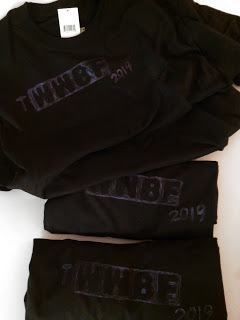


Thank you! Thank you! Thank you!
Many thanks to all of the vendors and the visitors who came to TWWBF. You made our festival launch s beautiful, uplifting, enlightening, and fun experience.
See you in 2020!
(Heather Brooks gave me the loveliest items as thank you swag from BDevlin Designs, Dea, and from her own H. L. Brooks Red August series.)
Published on September 23, 2019 07:10
September 20, 2019
War, Destruction, Truce. Repeat (with Superheroes)
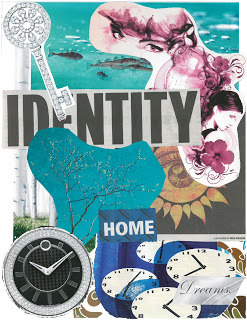
The Persistence of Memory, Book 1: Déjà vu
Karen Janowsky
New Adult(ish) speculative fiction with romantic elements
Mill City Press February 2019
The Persistence of Memory is a beguiling mash-up. It begins as a brutally immersive Holocaust testimony set in Germany in 1938. At the age of twenty-one, New Yorkers Daniel Hecht, his two best friends, and his mom discover that their U.S. citizenship can’t protect them from the racial hatred of the Nazis. Survival exacts steep costs that exchange one generation for another and smoothly transitions this story into science fiction. In the 21st century Daniel is a decorated war hero who is disillusioned, jaded, and patriotic. His inner turmoil and traumatic experiences generate emotional whiplash. Enter amnesiac Nina Archer. Who is she? What are her origins? Why does she fluently speak an ancient language? Add mystery and romance (mostly sweet, until very abruptly, it becomes explicit) to this layered and multifaceted tale, which includes social commentary about humanity’s mistakes replicated in every generation: slavery, genocide, abandonment of military service members in peacetime, and entrenched gender roles as artificial and misleading constructs of identity.
[Full review next week, after this reviewer survives the first annual The Write Women Book Fest. Author Karen Janowsky will participate as a panelist in Don’t Box Me In!: Career, Love, Family in Fiction and Real Life.]
http://www.karenjanowsky.com/
http://thewritewomen.weebly.com/event-schedule.html
Published on September 20, 2019 14:21
September 14, 2019
Singlehood, Red Riding Hood & Queen Goharshad

No Thanks: Black, Female, and Living in the Martyr-Free Zone
Keturah Kendrick
Non-fiction memoir
SheWrites Press June 2019
In a preface, eight intimate essays, and acknowledgements of the members of her international village, Keturah Kendrick uses the path of her own personal and professional journey to her integrity of self to encourage others to challenge the impositions of limiting gendered expectations. No Thanks constructs rational intellectual support for the benefits of deliberately choosing to live single and childfree, a declaration summed up on page 11: “I am single because I am enough for me.”
No Thanks is a provocative rejection of the entrenched belief that fertility is the primary source of worthiness and purpose for a female person’s womanhood; that fertility is the seminal value of womanhood. Humorous and poignant anecdotal personal stories and references to academic case studies examine the consequences and rewards for audacious female people who unapologetically choose themselves first, usually in ways and for reasons that are considered unremarkable when male people do it. No Thanks articulates society’s lack of gratitude, appreciation, and fair compensation for the essential and arduous labors of female people. Higher expectations and fewer, if any, bankable rewards are only two on a list of many reasons that make motherhood a sacrifice. Is it worth it? Yes, for some women and not for others. There are consequences for everyone in a world where one group is deified and the other group is vilified. Acknowledging and embracing that truth contributes to mentally healthy individuals in a present-day society built on reality, not unrealistic fairytales about what marriage and parenthood should be.
With thoughtful discourse about Black Atheists of America, a Churched Feminist, black love and black womanhood in television shows and movies from the 1990s; Toni Morrison’s Sula and Ava DuVernay’s Queen Sugar, Keturah Kendrick concludes No Thanks on a note of support for individuals and freedom that reiterates the clear statement from page 4: “We who believe in freedom also believe in people.”
https://shewritespress.com/portfolio/keturah-kendrick/
Red August
H. L. Brooks
YA contemporary (ca. 1980s) supernatural erotic fiction
Weatherhill August 2015
In the small town of Mahigan Falls, Maryland a battle rages between species. Hunters and some of the predators they target form unlikely personal alliances that infuriate racial purists on all sides. In Red August, H. L. Brooks creates an emotionally fraught coming-of-age tale with sixteen-year-old August Archer as its central figure. Intellectually brilliant and socially insecure, August struggles in the wake of her dad’s death and her family’s move from New York to Maryland. It’s a change that lands her in a new school where circumstances almost immediately go wrong, setting off a domino effect of bad acts and startling revelations.
Enter August’s mysterious, handsome neighbor, Faolan Conall, whose secrets link their families across generations and continents. Fresh spins on Scottish werewolf legends and Little Red Riding Hood incorporate themes about territorial encroachment, involuntary cultural assimilation, and species extinction with recurring threads about family legacies, overlapping destinies, and the stages of grief. August’s relationships with her mother Sylvia, and her grandmother Sorcha portray variations on themes about parents as multifaceted individuals with dynamic lives and identities that exist independently of their offspring.
Clever retooling of several tropes makes the cliché of having the one featured black character, who is three-dimensional in his distinctive intellectual complexity, as faithfully devoted to a Caucasian character standout in this otherwise socially progressive story. August’s advanced maturity regarding her sexuality and personal agency in the context of the volatile angst of burgeoning young adulthood generates an emotional tension that vibrates throughout Red August. For seasoned adult readers August’s romantic relationship may generate concerns for her to take more time to grow into herself as an individual before she throws herself into exclusively committed couplehood.
Fans of Anne Rice’s Sleeping Beauty erotic fiction who are interested in a YA slant with more layers of trope deconstruction and interpersonal connectedness should enjoy Red August. The battle continues in Red Archer.
[minor proofing note: Offsetting commas for names of characters when they’re being directly addressed are mostly omitted in dialogue.]
http://www.weatherhill.pub/publications.html
Brave with Beauty: A Story of Afghanistan
Maxine Rose Schur; illustr. Patricia Dewitt-Grush, Robin Dewitt, Golsa Yaghoobi
Children’s creative historical non-fiction
Yali Books October 2019
Taliban suicide bomber attacks and forbidding girls from attending school are only two disturbing headlines connected to 21st-century Afghanistan, but 700 years ago was a completely different reality. Herat, once the capital city of the Timurid Empire, which ran from Turkey to the border of China, was known as “the Florence of Asia” during Queen Goharshad’s reign of 50 years. Exquisite illustrations rendered as lush tapestries of saturated pigments and intricate design details project from the pages with the layered dimensions of a diorama. Paired scrollwork motifs pop in contrast against plain white page borders. Hafiz, Rumi, gorgeous mosques as architectural splendors, and a college for girls are referred to as reminders that the ancient culture of the Hindu Kush region was an advanced civilization in the arts and sciences long before many currently powerful western countries.
Schur uses creative license in describing Goharshad’s upbringing with her warmonger brothers to examine themes of martial arts versus marshaling the arts to generate peace and prosperity. Brave with Beauty recognizes the successful audacity of a woman who valued the arts as essential to society’s stability and evolution.
A very brief glossary, a guide for parents and educators, plus selected titles for reference and further reading conclude this enlightening historical nugget that will entice many readers to hunger for more information about Queen Goharshad and Afghanistan’s ancient cultural legacies.
https://yalibooks.com/books/brave-with-beauty-a-story-of-afghanistan/
Published on September 14, 2019 11:51
August 23, 2019
The Write Women Book Fest on Saturday, September 21, 2019

You are invited!#thewritewomen2019 IG: @thewritewomenbookfest
https://www.evite.com/event/03EDVX4ATL7YJIUVGEPJUS567DFYDY/activity?gid=03ED57UG7HVZ3ITO2EPJXRMB3BWEFY
https://www.facebook.com/events/652492448514372/
Hope to see you there!
Published on August 23, 2019 13:43
August 17, 2019
The Third Literary Life of Naguib Mahfouz
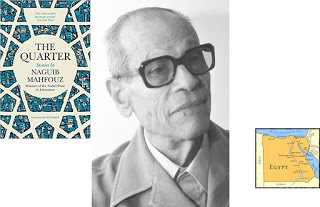
The Quarter by Naguib Mahfouz
Translated from Arabic by Roger Allen
Short stories
Saqi Books September 24, 2019
The Quarter is a time capsule. Found in 2018, these eighteen short stories written in the 1990s offer core samples of Egypt’s cultural layers. Its internal ideological conflicts and agitation from external sociopolitical forces inform the recurring themes of superstition, authoritarianism, and the oppression of women and poor people. Magical realism and mystical encounters regularly occur in this imaginary triangulated terrain of the cellar, the fort, and the fountain, where prodigal residents, bosses, Sitts (grandma, lady, madam), and women of assorted degrees of sexual virtue are counseled, blessed, judged or cursed by the Head of the Quarter and the mosque Imam.
Streamlined narrative structure and thumbnail characterizations suggest influences from the parables of the Qur’an and the Christian Bible. Prose with poetic sensibilities that encourage readers to acknowledge the subtle expression of everyday indignities of generational traditions as in “Bad Luck” when Unlucky Hassan, an adult, describes Sunbula, the object of his questionable affections, as “approaching puberty” as he pouts about his circumstances.
Many of these stories are contemplative. Characters lose and regain consciousness of the world. Intense human emotion is described as a contagion. Privileged people’s insatiable appetite for more wealth, more power sets events into motion, resulting in unpredictable outcomes.
Elif Shafak’s foreword and translator Roger Allen’s introduction provide personal, literary, and cultural context for the author, key elements of his writing process, and the entirety of his known works. When Allen writes, “He [Mahfouz] knew that novelists from turbulent lands did not have the luxury of being non-political,” the risk involved in acting on that knowledge is underscored by the violent 1994 attack against Mahfouz. That stabbing is most probably the reason the handwritten manuscript for The Quarter remained hidden until more than a decade after the author’s death, which is consistent with his career-long exploration of “the evident and the hidden” also mentioned in the introduction.
As a first story, “The Oven” with its focus on the ways in which an individual’s destiny is forged is bookended by the last story. “Tawhida” feels current with its themes of skin color hierarchies and multiculturalism. Ultimately, taking a person out of The Quarter does not take the survival skills honed in The Quarter out a person. This ending concludes the arc of the short story and of the collection before it smoothly segues into the author’s acceptance speech for his 1988 Nobel Prize for Literature as the first novelist in the Arabic language to receive that honor. On page 86, he says, “We are in the age of leaders responsible for the whole globe,” echoing one of the recurring themes in his writing. It resonates as a lament and as a call to action.
There is something visually compelling about the scanned images of Naguib Mahfouz’s handwritten pages of four of the stories. The manner in which they were discovered is reminiscent of unearthing hieroglyphs on papyrus stored in scrolls from ancient times. The messages of those ancient texts are essential components in the cultural and literary continuum, while sometimes being profound and inscrutable at the same time. The Quarter manifests similar tension.
Published on August 17, 2019 07:36
July 28, 2019
All Hail the Queens
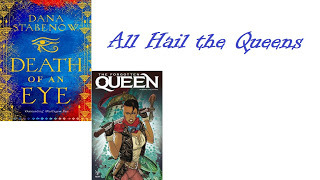
Death of an Eye by Dana Stabenow
historical mystery
Head of Zeus December 2018
True confession: My first reaction to seeing Dana Stabenow’s name on a book on a “My Lucky Day” display at the library was happiness that Kate Shugak #22 was finally available. Then the style of the cover art and the title snuffed my celebration. Opening the front cover to see the “Alexandria 47 B.C.” heading confirmed my suspicions. Death of an Eye is not a Kate Shugak story.* On page 9, when the main character muses on Alexandria, “It was a city to delight every sense…” that sentiment applies to this entertaining tale of political rivalries and palace intrigue during the reign of Cleopatra. Immersive descriptions convey the sights, sounds, scents, and dynamic energy of the people, politics, and landscape of ancient Egypt.
A map and a detailed cast of characters set the stage as fading moonglow yields to the sun on a day during the harvest season on the sixth year of Cleopatra VII’s reign. Clandestine meetings and murderous intentions bring Tetisheri (“Sheri”) and Apollodorus together in the service of the queen to identify homicidal conspirators and their motives before it’s too late. There’s one orchestrated error in judgement that clanks as an obvious ploy to endanger a character, but the overall quality of the writing swiftly overcomes it. In addition to conducting an investigation with implications that could destroy the empire, Sheri is an equal partner with her uncle in an import and export business, and she supports her own version of an Underground Railroad for oppressed and enslaved women.
Sheri and Apollodorus are friends. Their rapport bubbles with undercurrents. Both of them are keeping dangerous secrets as they follow the evidence. Death of an Eye is a murder mystery, an amateur sleuth procedural, a political thriller, and an intellectual courtship of Sheri and the reader to reconsider what is believed to be the truth about Cleopatra. The book by Stacy Schiff has now been moved to the top of my non-fiction TBR list.
Brisk narrative pacing, distinctive character voices, and the potential for mayhem at any moment combined with deftly applied historical points of reference and the author’s honed storytelling skills make Death of an Eye a one-sitting read.
*The author’s website claims a November 9th release date for K.S. #22, but other book sites show January 2020.
The Forgotten Queen, Vols. 1 - 4 by Tini Howard and Amilcar Pinna
graphic novel
Valiant Entertainment, LLC August 2019
A seemingly mundane research dive goes all kinds of wrong in the present day and unleashes destructive power from the past. Flashbacks to the times of Chinggis (aka Genghis) Khan and of Marco Polo and other actual figures provide historical context for the martial rampage of a lovely immortal called Vexana and by other labels. Family drama, shocking revelations, and an alternate variation on the origin story for Vlad the Impaler as Dracula are just a few of the provocative story elements that offer social commentary about millennia of constant human strife. The body count is high and bloody.
Captivating illustrated story panels leap from the page with nearly the depth of 3-D images. Color saturation and nuanced specificity in the drawn details of the distinctive individual faces, bodies, and backgrounds offer a cinematic quality to the visual narrative flow. The dialogue is often morbidly amusing and sarcastic.
In these first four volumes of The Forgotten Queen, unapologetically smart, strong, powerful women rule in this clever fable about living life as a team effort, and other core lessons.
Published on July 28, 2019 12:12
June 21, 2019
Love Is Love!!! (GLBT Book Month Bonus Reviews)
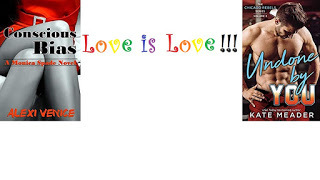 Conscious Bias (Monica Spade #1)
Conscious Bias (Monica Spade #1)Alexi Venice
Contemporary legal thriller(ish) May 2019
Monica Spade is keeping a secret. To protect her chances of someday making partner at the prestigious law firm controlled by men whose attitudes are trapped in the homophobic hysteria of earlier centuries, she’s not “out” in her professional life. Conscious Bias mixes workplace drama, personal crossroads, small-town politics and quirky humor into serious social commentary about identity and power. Recurring minor comedic threads add lighthearted elements to this tale of many flawed aspects in the pursuit of justice in the United States. Some missing connective tissue in transitions and sudden swings in tone will likely smooth out in the second entry in this series that shows potential for greatness.
CrossFit, the irresistible allure of baked goods and alcoholic beverages, along with searching for love occupy Monica’s thoughts when she’s not negotiating through a minefield of sexism, homophobia, and xenophobia in her professional career. Treacherous office politics, questionable loyalties, all kinds of inappropriateness, and violent threats keep Monica scrambling from one crisis to another while exposure looms closer every day. Underlying all of the dynamic confrontations and snappy dialogue are these questions: Are non-hetero people obligated to disclose their sexual orientation to everyone? Why? That’s not an expectation imposed upon hetero people.
Monica’s internal brooding about “outing” herself in her professional life resonates as being authentic to present-day concerns. Her next case should lead to another engaging adventure for readers.
Undone by You (Chicago Rebels #3)
Kate Meader
Contemporary romance March 2018
Dante Moretti is reserved. He’s older, wiser, and more experienced than gregarious Cade Burnett. Dante is also his boss. None of those facts stop Cade from pursuing Dante, who’s “out” when Cade is not. Their chemistry is too incendiary to resist. Their love story is emotionally nuanced, poignant, and filled with humorous charm. Set within the context of professional men’s hockey, Undone by You realistically depicts a broad range of attitudes from unconditional acceptance to virulent homophobia and rejection.
The Chase sisters, Chicago Rebels team members, families, and staff populate Kate Meader’s appealing universe filled with complicated people who love each other as passionately as they play to win in sports and in life. Being a novella instead of a novel is this story’s only shortcoming.
Published on June 21, 2019 09:24
June 8, 2019
Binge-Worthy Beach (or Anywhere) Reads*
 The McClain Brothers, Books 1—4:
The McClain Brothers, Books 1—4:Let Me Love You, Let Me Hold You, Let Me Show You, Let Me Free You
By Alexandria House
contemporary romance
Pink Cashmere Publishing 2018
Pineapples. Sextricity.
Just two of the terms Alexandria House spins into hilarious, steamy fun as Everett, Nolan, Neil, and Leland stumble their way into love with complicated, independent women—Jo, Bridgette, Sage, and Kim—who motivate each other to grow up and to step up. Beneath the outrageous raunch, melodrama, and high-frequency usage of ni**a and m-f, poignant overlapping threads about grief, child custody issues, domestic violence, infidelity, delusional obsession, substance abuse, low self-esteem, immigration status, and more create a compelling narrative tapestry. There are distinctive nuances in the characters’ voices shaped by region, age, experience, and personality. Multifaceted emotional authenticity fills each scene.
It’s so refreshing to read about an assortment of strong male characters whose displays of full emotional range are treated as unremarkably normal. That element plus the relatable intricate network of lovers, family, friends, frenemies, business associates, and rivals add depth and substance that linger after the last page has been read. The absence of the beloved McClain parents contributes both melancholy and buoyancy to this family’s connections to each other in a fundamental way that’s surprisingly similar to the Windham historical series by Grace Burrowes.
There are two disappointments: One brother’s complicity in exposing vulnerable women to sexual assault is treated with a somewhat cavalier attitude. Also, the only McClain sister, Kat, doesn’t receive her own full-length story, just a novella and having her journey interwoven across the four brothers’ books.
The entire series more than satisfies the cravings of readers who prefer their romantic fiction grown, sexy, smart, irreverent, and totally unconcerned with political correctness.
American Series:
American Dreamer, American Fairytale
By Adriana Herrera
contemporary romance
Carina Press 2019
In New York City, four best friends who are as close as brothers, Ernesto, Camilo, Juan Pablo, and Patrice, pursue their hearts’ desires professionally and romantically in this compulsively readable series from Adriana Herrera. The Dominican Republic, Puerto Rico, Cuba, Haiti, and Jamaica are their immigrant families’ countries of origin. An infusion of various elements from these vibrant, dynamic cultures enrich the U.S. and Nesto’s and Camilo’s love stories with Jude and Thomas in multiple ways.
The importance of family by blood and by choice is celebrated. Sons’ healthy relationships with their mothers, sisters, female cousins, and aunties are also featured in non-stereotypical ways in this emotionally layered saga about work-life balance and priorities. Xenophobia, bigotry, toxic people, and homophobia are only a few of the heavy threads Adriana Herrera organically weaves into overwhelmingly upbeat yet realistic stories about the risks and rewards of making oneself vulnerable to another person. Profound emotional intimacy combined with joyous indulgence make the explicit sex scenes almost combust from the pages, while the giddy uncertainty of the potential for something exclusive and committed add charm to these men’s courtships. Elements of squick are easily skimmed or skipped without detracting from the overall heat of the characters’ sexual chemistry.
Fans of Cat Sebastian’s historical romances who are in search of some contemporary selections should enjoy this American series.
Black Fortunes by Shomari Wills
The Story of the First Six African Americans Who Escaped Slavery and Became Millionaires
non-fiction biography, U.S. history
Amistad 2018
Ever heard of black Californian land baron and politico William Alexander Leidesdorff? No. What about New York financier Jeremiah Hamilton? Another no. Well, their stories are as fascinating as the tumultuous journeys of the six featured trailblazers: Mary Ellen Pleasant, Robert Reed Church, Ottawa W. Gurley, Hannah Elias, Annie Turnbo Malone, and Madame C. J. Walker, whose ostentatious lifestyle may have been a smoke screen. The introduction to Black Fortunes states that “Black millionaires disrupt the stereotypes of black economic impotence.” This book accomplishes the same.
Meticulously researched and annotated, the text drops facts like explosive knowledge bombs in each chapter. The people of the five major tribes of Oklahoma fought with the Confederacy during the [Civil] war… [page 79] Maya Angelou was San Francisco’s first black streetcar conductor in 1944. [page 106 footnote] Shomari Wills uses a comprehensive examination of region, time, and political climate at the national and local levels to set the stage for each featured individual’s saga in context with familiar historical figures such as Ida B. Wells, Frederick Douglass, and John Brown. The jumps from one biography to another at pivotal moments interrupt the otherwise brisk narrative pacing, but the intrigue and danger entice readers to continue.
One other editorial choice is also jarring: the usage of sanitized terms for the daily atrocities endured by enslaved and oppressed people. “Concubine” and “tryst” are used to describe non-consensual sexual encounters and rape. “Migrants” is substituted for describing newly freed slaves fleeing in terror from racist violence. On page 81, the armed soldiers who force-marched indigenous North Americans on the Trail of Tears are described as having “chaperoned their removal from their homelands.” (Is that erudite sarcasm?) Reading a documented account from one of its survivors or a visit to the Smithsonian’s National Museum of the American Indian will make it clear that annihilation was the ultimate goal of that particular atrocity. Only a few passages suffer from this odd filtering, and the scope and historical interlocking facts of Black Fortunes move across the U.S., social strata, and racial barriers with the drama of an adventure novel.
This text educates, enlightens, and inspires. Everyone would benefit from reading Black Fortunes. Robert F. Smith, the billionaire who recently pledged to pay off the student loans of the 2019 graduating class from Morehouse College is mentioned in the epilogue, bringing present-day relevance to the ambitious triumphs of enslaved and racially stigmatized people who overcame all of the odds against them in the 1800s and early 1900s. Bravo.
*Already busted your book-buying budget? Borrow these works from your local library or request them if they’re not available. Doing so is free and helps build buzz about worthy titles from smaller presses and lesser known authors.
Published on June 08, 2019 08:01
May 20, 2019
If Loving You Is Wrong... Outlawed, Forbidden, Taboo Lovers
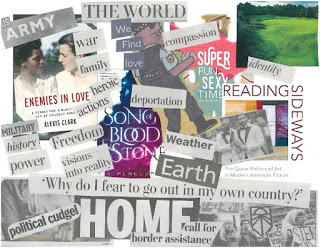
Enemies in Love by Alexis ClarkA German POW, a Black Nurse, and an Unlikely Romance Non-fiction biography, sociopolitical and military historyThe New Press May 2018
Decades before Loving v. Virginia, African-American U.S. Army nurse Elinor Powell and German POW Frederick Albert defied the military, Jim Crow, society’s expectations, and many other challenging circumstances in order to love each other. Enemies in Love tells their harrowing personal tale in the global context of the aftermath of World War I, Hitler’s rise to power, and illogical racial contradictions in everyday civilian life and in the U.S. military during World War II and afterward.
Elinor and Frederick’s story reads like an exquisitely researched historical novel. Family drama, personal demons, war, forbidden attraction, clandestine meetings, and a constant struggle to find a safe place for their superficially unconventional family to settle and to thrive are woven among rarely promoted facts such as the following: The transfer of hundreds of thousands of Axis prisoners of war to American soil is one of the great untold stories of World War II. [page 73]
Eyewitness accounts and impressions shared by family and friends infuse a sense of emotional intimacy in the revelations about Elinor and Frederick as individuals and as a couple. The complexity of their personalities and their strategies for coping with setbacks highlight the daily grind of living in institutionally discriminatory environments.
Generational differences in dealing with racism are also compared and contrasted. Substantial end notes and a detailed index combined with several pages of black and white family photos offer a clear picture of two human beings who negotiated the treacherous and often arbitrary nature of racially segregated society to achieve the ultimate victory of remaining together in love.
Song of Blood & Stone by L. Penelope Earthsinger Chronicles, Book 1SciFi fantasy St. Martin’s Griffin July 2019
Blending the wisdom of ancient parables, anthropomorphic fables, and the sacredness of organized religious philosophies with recurring themes in the endless cycles of human conflict, L. Penelope has composed a symphony that resonates across time and space with its essential truths. Song of Blood & Stone evokes the emotional gravitas of Parable of the Sower by Octavia Butler, Stephen R. Donaldson’s Thomas Covenant, and Tanya Huff’s Four Quarters stories while projecting its own distinctive voice. Toss in some magical realism, a spin on Sleeping Beauty, and a little steampunk.
Age-wise Jasminda, the struggling farmer, and Jack, the military commander, are young adults, but the story threads weave a mature tale of political intrigue, personal betrayals, misdirection, and complicated romantic entanglements—along with unexpected consequences. Singers versus the Silent. Elsira versus Lagrimar. The Sleeping Queen versus the True Father. Each chapter begins with a parable that sets the tone for the next movement in this beautifully orchestrated work about the haves and the have-nots.
The U.S. or Venezuela or Darfur—anyplace where there’s currently a battle raging about equitable access to resources and opportunities to thrive could stand in for the fictional nations of Elsira and Lagrimar.
On page 292 one of the main characters thinks, “It was as if history and myth had intertwined somehow, and vital facts had been lost or obscured.” With the modern environment of Fake News in mind, the author reminds readers of the cascading impacts of information filtered through assorted biases across generations and around the world. It can generate results like playing a global game of Telephone/Chinese Whispers.
Song of Blood & Stone launches the Earthsinger Chronicles into its own stratosphere of energetic storytelling. Fingers crossed that the second entry in this series reveals more about the mysterious catalyst characters who make pivotal cameos.
Reading Sideways by Dana Seitler The Queer Politics of Art in Modern American Fiction Non-fiction Fordham University Press July 2019
Dana Seitler invites readers of Reading Sideways to engage in dynamic conversation about the scope and depth of intersectionality in the late 19th and early 20thcenturies. In the subtitle, “queer” is applied in its broadest definition of differing in some odd way from what is usual or normal [Webster’s Dictionary] including, but not limited to, sexual orientation. The author sets up the focus of this text early in the introduction by describing the intersection of gender, sexuality, and ethnicity as directly influencing art forms in American literary fiction leading into the 20th century.
Each of the four substantial chapters is also summarized with a paragraph or two to provide an accurate overview of this ambitious study about art that demands conscious participation from its viewers and readers. Page 2 outlines the author’s methodology: “To track these practices, I enact an interpretive method that I call ‘lateral reading’ or reading sideways, a mode of interpretation that moves horizontally through various historical entanglements…” The shaping of the author’s approach continues on page 7:
…I am suggesting that the late nineteenth and early twentieth century designates [sic] a moment in history, though not the only one, in which we can see the transformation of the question of the aesthetic in relation to political and social practice.
A survey of literary theory using pivotal works of the fin de siècle period begins. Specific fiction authors and titles are exhaustively examined through isolated elements and themes relative to sociopolitical contexts in geography, social class, gender, age, ethnicity, and relationship status. The tone of genuine curiosity and thinking aloud makes the academically dense and intellectually engaging content accessible for the general public. Reading Sideways drills as deep as it spans wide while also presenting concepts of art in various forms as the Russian nesting dolls of human expression.
The author uses the deconstruction of context, voice, and point of view to parse recognition of current social imperatives while critiquing and reimagining them. Each chapter applies a different angle of approach to ask how the status quo shifts and evolves to include and exclude individuals and communities. Recurring themes of personhood generate friction against the limitations of the English literary canon. Aesthetic philosophy, social ideology, political implications, and literary theory overlap and diverge supported by plentiful quotes and notations.
“…over the course of this book, we have witnessed the emergence , in Chapter 1, of an aesthetics of the interrogative, the subjunctive, and the unfinished; in Chapter 2, an aesthetics of the small and the low; in Chapter 3, of doubt; and finally, in Chapter 4, of allusion.” [page 160]
Reading a few pages at a time over several days or weeks may offer the most enjoyable way to digest this cerebrally layered content. Illustrations, end notes, and an index provide a treasure trove of intellectual gems worthy of further study.
****This review contains sexually explicit content**** Super Fun Sexy Times, Vol. 1 by Meredith McClarenErotica graphic novelOni Press and Limerence Press August 2019
Everyone needs love—even super heroes, archnemeses, super villains, mercenaries, mad scientists, assassins, interstellar beings, non-binary, and gender fluid people. In Super Fun Sexy TimesMeredith McClaren’s nuanced characters explore the kink spectrum with humor, compassion, and without judgement. Volume one of what promises to be a titillating series with as much emotional depth as sexual heat is sure to hook adult readers into getting to know more about these intriguing characters. These initial thumbnail biographies and vignettes are effective teasers.
The sexually explicit illustrations are mostly anatomically correct with the exception of one black female’s genitalia. Black box is slang for a black woman’s vagina, but the inner flesh is actually in shades of pink. The attempt made to render that contrast falls a bit short. Generally, humans and other character species are drawn with strong feline and anime influences rendered in a predominately pastel and gray scale palette. Skin colors for the black characters sometimes translate with a grayish undertone that remains common in comics even though it’s not a shade found naturally in real flesh (severely dry and unmoisturized skin included). This challenge in producing truly brown shades to represent people of color continues throughout the industry. Cosmetics manufacturers finally solved their brown pigment issues. Comics will, too. (Eventually?) And in a refreshing switch, almost all of the simply human characters are people of color.
Super Fun Sexy Timesorganically includes characters as multifaceted representation across ethnicity, age, species, professions, body types, and sexual orientations and identities. Sexual intimacy in each chapter starts with revelations and brief conversations in support of the idea that foreplay begins in the heart and mind.
Published on May 20, 2019 12:07
May 10, 2019
Bookish Fun in Phoenix at Metro Barnes & Noble
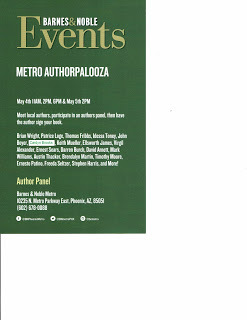
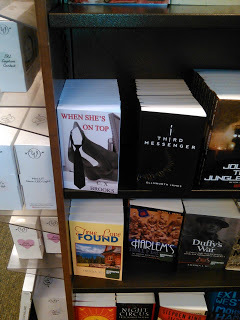
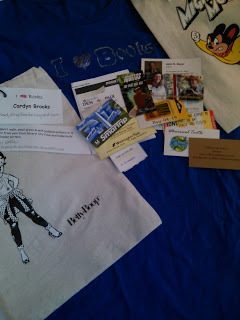
Go west, young (at heart) authors!
MARC train, then free shuttle to BWI? Check.
Easy bag drop-off at Frontier Airlines? Check.
Enthusiastic pat down from a dedicated TSA agent makes me think maybe we're engaged--or at least dating!
Smooth boarding process. New, clean cabin interior. Window seat. Restful snooze until arrival. (Many thanks to the adorable toddler who waited until we were deplaning to melt down in spectacular fashion.)
Metro Valley mass transit from Phoenix Sky Harbor Airport to Authorpalooza for good times with booklovers, talented authors, and a team of phenomenal booksellers led by a visionary store manager who supports creatives and the arts in dynamic ways.
It was a pleasurable privilege to participate with panelists on the Saturday 5/4 group at 6 p.m.: Virgil Alexander, Ellsworth James, Timothy Moore, and Keith Mueller. Fellow Black Opal Books author John Beyer was in the 2 p.m. session.
Lively book chat, a couple of rounds of Tic Tac Trope (with a community's dangerous secrets, ripped from the headlines, and genetic engineering themes added in honor of The Devil's Rifle, Mirandized Nation, Third Messenger, and Murder in Copper)
"I <3 Books" t-shirts, bookmarks, business cards, candy, and novelty canvas totes with vintage comics characters given to Tic Tac Trope winners and participants.
Fun, fun, fun!
(My government name was accidentally listed on the post instead of Cardyn Brooks or C. X Brooks. No biggie.:-)
Published on May 10, 2019 12:42



